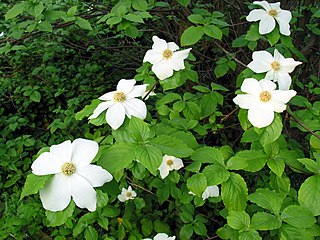
Cornus nuttallii, the Pacific dogwood,western dogwood, or mountain dogwood, is a species of dogwood tree native to western North America. The tree's name used by Hul'q'umi'num'-speaking nations is Kwi’txulhp.
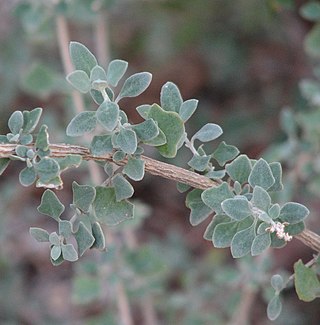
Atriplex amnicola, commonly known as river saltbush or swamp saltbush, is a species of shrub in the family Amaranthaceae. Endemic to Western Australia, it is native to the floodplains of the Murchison and Gascoyne Rivers.

Frangula californica is a species of flowering plant in the buckthorn family native to western North America. It produces edible fruits and seeds. It is commonly known as California coffeeberry and California buckthorn.
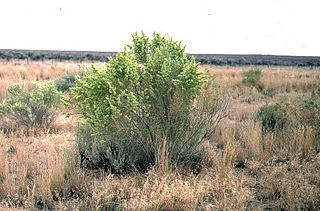
Atriplex canescens is a species of evergreen shrub in the family Amaranthaceae native to the western and midwestern United States.

Atriplex confertifolia, the shadscale or spiny saltbush, is a species of evergreen shrub in the family Amaranthaceae, which is native to the western United States and northern Mexico.

Atriplex hymenelytra, the desert holly, is silvery-whitish-gray shrub in the family Amaranthaceae, native to deserts of the southwestern United States. It is the most drought tolerant saltbush in North America. It can tolerate the hottest and driest sites in Death Valley, and remains active most of the year.
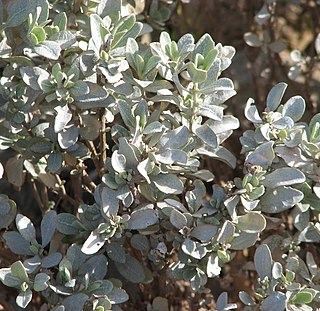
Atriplex vesicaria, commonly known as bladder saltbush, is a species of flowering plant of the family Amaranthaceae and is endemic to arid and semi-arid inland regions of Australia. It is an upright or sprawling shrub with scaly leaves and separate male and female plants, the fruit often with a bladder-like appendage.

Arctostaphylos montaraensis, known by the common name Montara manzanita, is a species of manzanita in the family Ericaceae.

Atriplex argentea is a species of saltbush known by the common names silverscale saltbush and silver orache. It is native to western North America from southern Canada to northern Mexico, where it grows in many types of habitat, generally on saline soils.
Atriplex cordulata is a species of saltbush known by the common names heartscale and heart-leaf orache. It is endemic to the Central Valley and its San Joaquin Valley of California, where it grows in areas of saline and alkaline soils.

Atriplex lentiformis is a species of saltbush.
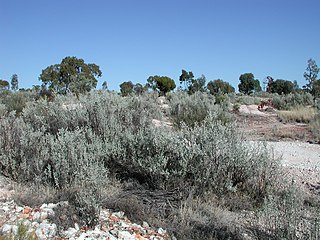
Atriplex nummularia is a species of saltbush from the family Amaranthaceae and is a large woody shrub known commonly as oldman saltbush. A. nummularia is native to Australia and occurs in each of the mainland states, thriving in arid and semi-arid inland regions.

Atriplex pacifica is a species of saltbush known by the common names Davidson's saltbush, South Coast saltbush, and Pacific orach.
Atriplex parishii is an uncommon species of saltbush known by the common names Parish's saltbush and Parish's brittlescale. It is native to central and southern California where it can occasionally be found along the immediate coastline, and the Channel Islands. Its distribution extended historically into the western edges of the Mojave Desert and Baja California and it may still exist there.
Atriplex parryi is a species of saltbush known by the common name Parry's saltbush. It is native to the deserts and plateaus of eastern California and western Nevada.
Atriplex spinifera is a species of saltbush, known by the common names spiny saltbush and spinescale saltbush.

Atriplex watsonii is a species of saltbush known by the common name Watson's saltbush, or Watson's orach. It is native to the coastline of California and Baja California, where it grows in coastal areas with saline soils, such as salt marshes and beach scrub, with other halophytes such as saltgrass. It extends inland in the Los Angeles Basin, and along the Santa Ana River.
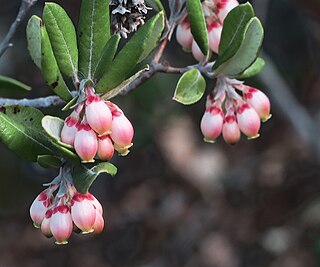
Xylococcus is a monotypic genus of flowering plants in the heather family which contains the single species Xylococcus bicolor, commonly known as the mission manzanita. It is a burl-forming, evergreen shrub with leathery leaves and smooth dark reddish bark. From December to February, white to pink urn-shaped flowers adorn the foliage, often attracting hummingbird pollinators. It is native to southern California and the Baja California Peninsula, south to the Sierra de la Giganta. There is growing concern over the future of this plant, referred to as the "queen of the elfin forest, " as it may possibly lose up to 88% of its habitat and its wild seedlings are failing to survive more than a full year.

Atriplex gardneri is a species of flowering plant in the amaranth family known by the common name Gardner's saltbush. It is native to western North America from British Columbia to Saskatchewan in Canada south to Nevada and New Mexico in the United States. The specific epithet of the species, gardneri, is misnamed after its first collector, Alexander Gordon. The naturalist Alfred Moquin-Tandon was under the impression that Gordon's last name was Gardner.

Atriplex acanthocarpa is a species of flowering plant in the amaranth family known by the common names armed saltbush, tubercled saltbush, and huaha. It is native to North America, where it is limited to the US states of Arizona, New Mexico, and Texas, and adjacent Mexico.

















